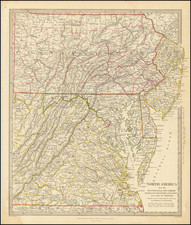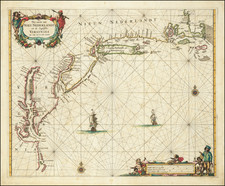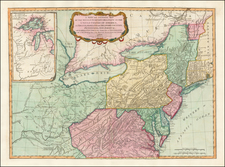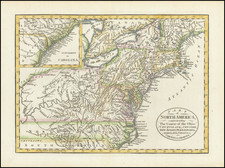Scarce first edition of John Thornton's fine charting of the Chespeake, Delaware Bay and contiguous regions.
As noted by Bill Wooldridge in his work Mapping Virginia, to be published in October 2012
Considerable uncertainty surrounds the date of Thornton's map. The second edition of the map carries Samuel Thornton's name. When John Thornton died in 1708, he left his son Samuel all his "Mapps, Charts, Copys, Books, Instruments, Copper graved Plates and all other things belonging to my calling." This map was probably struck from one of those "Copper graved plates," with Samuel's name substituted for John's, within a year or two of the son's succession to his father's business in 1708. The more difficult question concerns the date of the original engraving by John Thornton; On the Map, which uses it as the cover illustration, concludes that it first appeared between 1682 and 1685.
If this 1682-85 span were indeed correct, the map would have been the small-scale model for a large, showy four-sheet wall map of Virginia . . . .that first appeared in about 1701. John Thornton dedicated the wall map to Micajah Perry, a merchant in the Virginia trade. This map, however, may not be that early. Henry Taliaferro has noted that it seems to use data from -- and in fact, to be almost a companion piece to -- a John Worlidge map of New Jersey, also published by Thornton, which can be dated to about 1699. This analysis implies that the original copperplate for Thornton's map is approximately contemporaneous with the appearance of the wall- map version in about 1701. The New York Public Library's online images for its exhibit "In thy map securely saile," which includes the Thornton wall map, notes that "Oddly, this [wall] map was never reduced to atlas format." Thornton's map is from an atlas and resolves the anomaly highlighted by the NYPL.
In short, Thornton's map appears to be an atlas-sized version of a Thornton four-sheet wall map that Coolie Verner called "indubitably the most important" Virginia map to appear since John Smith, "the most accurate and detailed of all the maps studied . . . between 1650 and 1750," surpassing the Herrman map in geographical utility and cartographical value.
Whatever its exact date, Thornton's map summarizes what was known of Virginia, and how Englishmen saw Virginia, at the beginning of the eighteenth century. The Augustine Herrman data have now been digested and modestly amplified. Virginia remains very much a coastal and riverine colony, with political subdivisions (counties) and a host of English place-names around the Bay and up and down the rivers, but the map shows almost nothing in the west. Seagoing vessels could not ascend the rivers above the rapids at present-day Washington, DC (Great Falls), Fredericksburg, Richmond and Petersburg. A line running through these points, the "Fall Line," marked the western limit of significant settlement. As its maps demonstrated, a century after Jamestown, the colony was still a seaboard enclave, facing across the Atlantic to England and the Old World.
John Thornton was a respected and prominent chartmaker in London in the latter part of the seventeenth century. He was one of the final members of the Thames School of chartmakers and served as the hydrographer to the Hudson's Bay Company and the East India Company. He produced a large variety of printed charts, maps, and atlases in his career, but he was also a renowned manuscript chart maker. Born in London in 1641, he was apprenticed in the Drapers Company to a chartmaker, John Burston. After being made free of the company (1665), he was part of the combine that took over John Seller’ English Pilot in 1677. Thornton was trusted by the naval and navigational establishment of the day; one of his clients was Samuel Pepys, naval administrator and diarist. Thornton died in 1708, leaving his stock to his son, Samuel, who carried on the business.
Samuel, born in ca. 1665, also had apprenticed in the Drapers Company and was made free a year after his father’s death. He continued the business until 1715, when he died. His stock then passed to Richard Mount and Thomas Page.









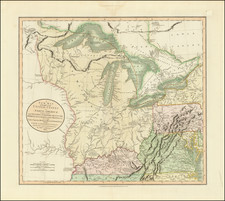
![A New and Exact Map of the Dominions of the King of Great Britain on ye Continent of North America . . . [Beaver map]](https://storage.googleapis.com/raremaps/img/small/101277.jpg)
